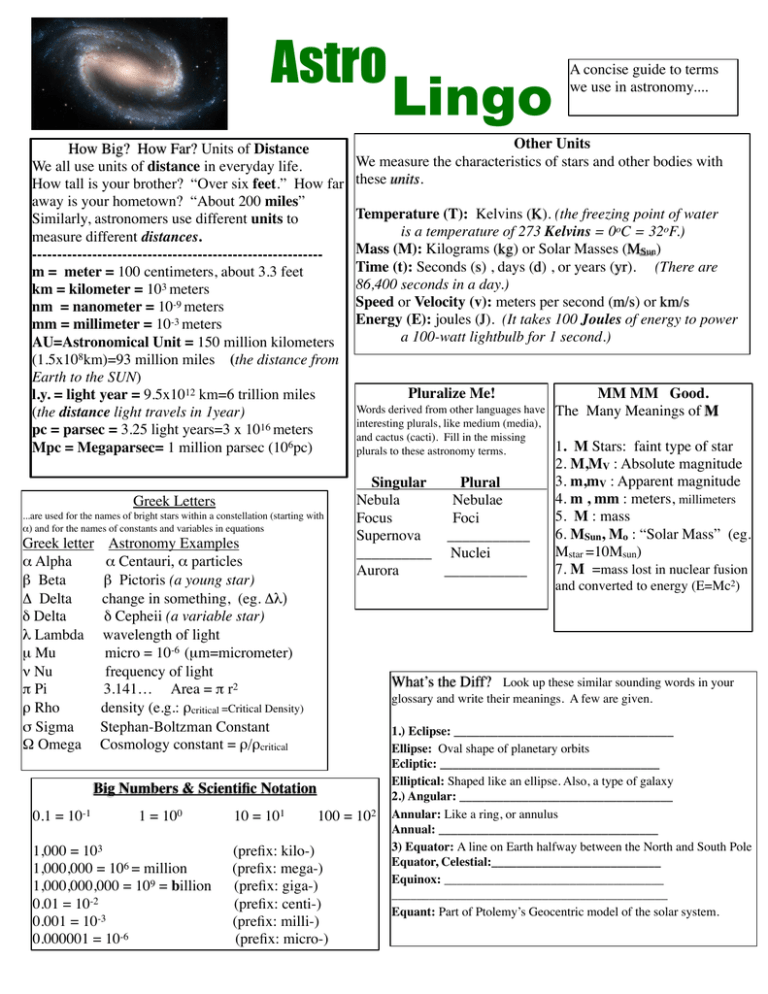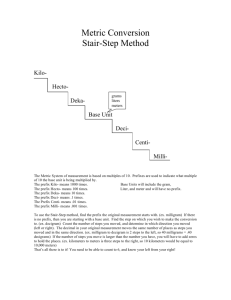AstroLingo
advertisement

Astro How Big? How Far? Units of Distance We all use units of distance in everyday life. How tall is your brother? “Over six feet.” How far away is your hometown? “About 200 miles” Similarly, astronomers use different units to measure different distances. ---------------------------------------------------------m = meter = 100 centimeters, about 3.3 feet km = kilometer = 103 meters nm = nanometer = 10-9 meters mm = millimeter = 10-3 meters AU=Astronomical Unit = 150 million kilometers (1.5x108km)=93 million miles (the distance from Earth to the SUN) l.y. = light year = 9.5x1012 km=6 trillion miles (the distance light travels in 1year) pc = parsec = 3.25 light years=3 x 1016 meters Mpc = Megaparsec= 1 million parsec (106pc) Greek Letters ...are used for the names of bright stars within a constellation (starting with α) and for the names of constants and variables in equations Greek letter α Alpha β Beta Δ Delta δ Delta λ Lambda µ Mu ν Nu π Pi ρ Rho σ Sigma Ω Omega 0.1 = 10-1 Astronomy Examples α Centauri, α particles β Pictoris (a young star) change in something, (eg. Δλ) δ Cepheii (a variable star) wavelength of light micro = 10-6 (µm=micrometer) frequency of light 3.141… Area = π r2 density (e.g.: ρcritical =Critical Density) Stephan-Boltzman Constant Cosmology constant = ρ/ρcritical Other Units We measure the characteristics of stars and other bodies with these units. Temperature (T): Kelvins (K). (the freezing point of water is a temperature of 273 Kelvins = 0oC = 32oF.) Mass (M): Kilograms (kg) or Solar Masses (MSun) Time (t): Seconds (s) , days (d) , or years (yr). (There are 86,400 seconds in a day.) Speed or Velocity (v): meters per second (m/s) or km/s Energy (E): joules (J). (It takes 100 Joules of energy to power a 100-watt lightbulb for 1 second.) Pluralize Me! Words derived from other languages have interesting plurals, like medium (media), and cactus (cacti). Fill in the missing plurals to these astronomy terms. Singular Plural Nebula Nebulae Focus Foci Supernova ___________ __________ Nuclei Aurora ___________ 1,000 = 103 1,000,000 = 106 = million 1,000,000,000 = 109 = billion 0.01 = 10-2 0.001 = 10-3 0.000001 = 10-6 10 = 101 MM MM Good. The Many Meanings of M 1. M Stars: faint type of star 2. M,MV : Absolute magnitude 3. m,mV : Apparent magnitude 4. m , mm : meters, millimeters 5. M : mass 6. MSun, Mo : “Solar Mass” (eg. Mstar =10Msun) 7. M =mass lost in nuclear fusion and converted to energy (E=Mc2) What’s the Diff? Look up these similar sounding words in your glossary and write their meanings. A few are given. Big Numbers & Scientific Notation 1 = 100 Lingo A concise guide to terms we use in astronomy.... 100 = 102 (prefix: kilo-) (prefix: mega-) (prefix: giga-) (prefix: centi-) (prefix: milli-) (prefix: micro-) 1.) Eclipse: ___________________________________ Ellipse: Oval shape of planetary orbits Ecliptic: ___________________________________ Elliptical: Shaped like an ellipse. Also, a type of galaxy 2.) Angular: __________________________________ Annular: Like a ring, or annulus Annual: ___________________________________ 3) Equator: A line on Earth halfway between the North and South Pole Equator, Celestial:___________________________ Equinox: ___________________________________ ____________________________________________ Equant: Part of Ptolemy’s Geocentric model of the solar system.




